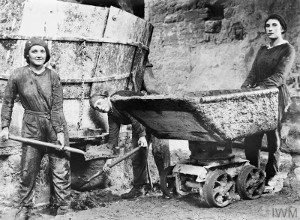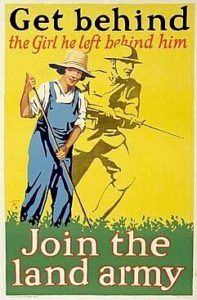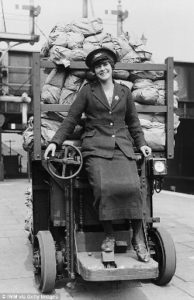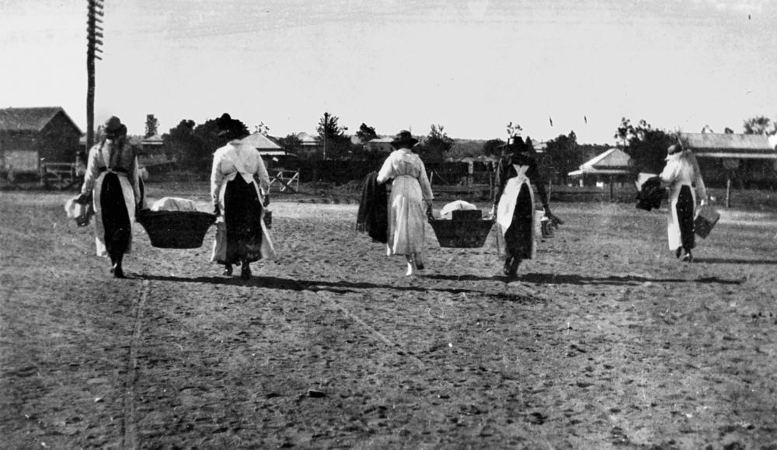[dropcap]O[/dropcap]ver eight and a half million men enlisted from the UK to fight in the First World War, Nearly a million of them died and over two million were injured. The effects of that would be felt for generations but the changes on the home front were just as dramatic and much swifter. The war caused the whole fabric of the society at the time to change. Some were lasting changes, some were short lived but what happened shaped the society in which we now live. Workplaces changed in a way few thought possible in 1914. The war was not only confined to the front, in daily newspaper reports and lists of casualties it laid it’s influence on everything that people took for granted.

Women in the north of England were already used to working in the vast textile industries across the industrial centres of Lancashire but even as their contribution was needed it probably wasn’t as valued as much as it should have been, they were certainly paid a lot less. Across the rest of the country it wasn’t as if women didn’t work before the outbreak of war, six million of them did, but usually as domestic servants, cooks or chambermaids. Low paid jobs, often in almost indentured conditions.
The war changed that. Suddenly those factories and many more were not just producing goods for profit, they were producing desperately needed military goods. Not only that but when the usual work force marched off to the war it was the women who were needed to take up the slack. And they did by their hundreds of thousands. It wasn’t only societal attitudes which changed but those of the women themselves. Some of the jobs continued, with a wartime emphasis like textiles and women working at the coal mines, sorting coal and moving heavy tubs and sacks; dirty and physically demanding work. No change there, but there were new industries and jobs as the male contingent of the work force dwindled. A lot of women realised that not only was there an opportunity but as they took on the tasks that they could do the work as well as men.
A lot is already known of the munition factories where women were quickly trained to produce ammunition and artillery shells in their millions. The women who were often known as canaries because of the yellow colour their skin turned because they had been working with TNT, packing artillery shells. A million of them worked in industrial conditions around the country to produce the ammunition desperately needed at the front; and many of them died, from prolonged exposure to TNT and amatol or from catastrophic explosions, despite the strict regimes they had to follow to prevent such an event. An explosion at Chilwell in Nottingham killed 134 workers, another at Silvertown in West Ham killed 73 and Ashton-under-Lyne in 1917 killed 43 people.

 But in every part of society there was a quantum shift in the workforce. Statistics from the National archives show what a change there was. In July 1914 only 2,000 women had been employed in government dockyards, factories and arsenals but by the end of the war that figure had increased to 247,000. In the transport industry the number went up by 555% to over 100,000. Increases were seen across the whole workforce, in agriculture, banking and the civil service.
But in every part of society there was a quantum shift in the workforce. Statistics from the National archives show what a change there was. In July 1914 only 2,000 women had been employed in government dockyards, factories and arsenals but by the end of the war that figure had increased to 247,000. In the transport industry the number went up by 555% to over 100,000. Increases were seen across the whole workforce, in agriculture, banking and the civil service.
Women were working everywhere.
Working in the factory of Charles Macintosh & Sons in Manchester making car and truck tyres and later, the rubber components of gas masks. These roles were not classed as manual labour but needed technical skills.
Some signed up to serve and joined the Women’s Army Auxiliary Corps which was formed in 1917. Subsequently renamed the Queen Mary’s Army Auxiliary Corps in 1918 it was disbanded in 1921 but in that time about 57,000 women joined, performing non-combatant roles such as clerical and mechanical work mostly in the UK.
Nursing was a prime function that women undertook at the front. Queen Alexandra’s Imperial Military Nursing Service was part of the army before the war but a reserve was formed followed by the Territorial Force Nursing Service. In the first weeks of the war these services mobilised for duty. Greatly expanded to over 23,000 they served throughout the war. Alongside them were many other organisations, some government sanctioned like the Volunteer Aid Detachments from the British Red Cross and the Order of St John to almost maverick operations who wouldn’t take no for and answer.
Dr Elsie Maud Inglis, a suffragette and one of the earliest qualified female doctors offered her services to the War Office. Instead of taking up her offer she was apparently told to ‘Go home and sit still’. She did neither.
Instead she founded the Scottish Women’s Hospitals and travelled to Serbia in early 1915 to treat casualties and by 1918 there were 14 units operating in that theatre. She was taken prisoner in 1915 and repatriated to the UK. Refusing to sit still again she moved with another unit to Russia from where she was again repatriated in 1917 after the revolution. She died at the Central Station Hotel, Newcastle the day after her return home in November 1917. ‘There’s the girl who clips your ticket for the train, And the girl who speeds the lift from floor to floor, There’s the girl who does a milk-round in the rain, And the girl who calls for orders at your door. Strong, sensible, and fit, They’re out to show their grit.’ Jessie Pope
Without women working as chemists, concrete could not have been made. They helped produce the sodium bicarbonate, baking powder, used as a leavening agent in baking, but also used then as a pest control, a fire extinguisher and, more importantly for the war effort to reduce the spread of phosphorus from incendiary bullets inside an afflicted soldier’s wounds.
Women ground flour, brewed beer and worked the land.
Mrs Edith Smith isn’t a name that springs to mind when one thinks of women’s rights and yet the role she played during the war had such far reaching consequences. In 1914 the Women’s Police Volunteers were formed but in December 1915 in Grantham, Lincolnshire Smith was the first woman to be sworn in as a police constable, answerable to the Chief Constable. Not as an ancillary or with a lessor role like the Police Volunteers but as a fully functioning constable with official powers of arrest. This, if you are not aware is a big deal, bestowing the right to deprive someone of their liberty is not done lightly and the freedom to go about your business without interference is a major right in common law. At the time she couldn’t even vote and faced opposition from parts of the government but she had the full support of the Chief Constable and Watch Committee because they thought her work was vital given the very particular problems that the town faced as a result of war conditions.
Soon across the UK around 4000 women took on policing functions as voluntary patrols, aiming to ensure orderly behaviour in parks, railways stations and other public spaces. Some were employed to supervise women workers in the munitions factories. Edith Smith’s duties, predominantly regulating the moral’s of women and girls meant her role was different to the men, she was employed because women’s police work was seen from the start as separate and different from that of policemen, but it was a start and the war was the catalyst to that.
But Edith Smith’s employment had one more, important change to give. The introduction of the Sex Disqualification (Removal) Act in 1919 stated that a person could not be ‘disqualified by sex or marriage from the exercise of any public function’.
The Baird Committee of 1920, which looked at employment of women on police duties, agreed there was no longer a legal justification for excluding women. This influenced other professions and for the first time women could become lawyers, vets and civil servants.
 Women drove the buses, they drove the trams, they worked as conductresses and mechanics. As members of auxiliary services they built and repaired everything: guns, trucks, trains, motorbikes, aircraft, uniforms. Anything that was involved in the war effort had a woman’s hand somewhere in the process of production.
Women drove the buses, they drove the trams, they worked as conductresses and mechanics. As members of auxiliary services they built and repaired everything: guns, trucks, trains, motorbikes, aircraft, uniforms. Anything that was involved in the war effort had a woman’s hand somewhere in the process of production.
A lot of them probably hated it. Dirty, greasy, cold and monotonous work they didn’t see themselves as being at the forefront of the equality movement. They were just doing their bit for the war effort, mucking in to defeat the enemy, or because of necessity and the chance to earn more money than they could in their previous employments.
It wasn’t just in the UK. In France and Germany, Belgium and Austria, Australia and later the US women were thrown into roles that had been denied to them previously. Some happily went back to their former lives once hostilities were over, others took the opportunity and made everything that could of it.
At least one million women were formally added to the British workforce between 1914 and 1918. But at the end of the war, with the men returning, there was a lot of disquiet about women taking the jobs. Some of the jobs became redundant anyway as the war effort ramped down but women had found themselves empowered by the past four years.
It would be nice to think that the day after the Armistice women’s rights would be enshrined into law but they weren’t, but things couldn’t go back to normal. The government could not ignore the new reality and in 1918 introduced the Representation of the People Act which among other things gave the vote to all women over the age of 30, not perfect and not equal but a million miles from what the situation had been four years earlier.
The Second World War had a similar effect as women were conscripted into industrial positions and rightly agitated for equal status but it took until 1970 before Barbara Castle, inspired by a group of machinists at the Ford, Dagenham plant, could introduce the Equal Pay Act into the UK.



